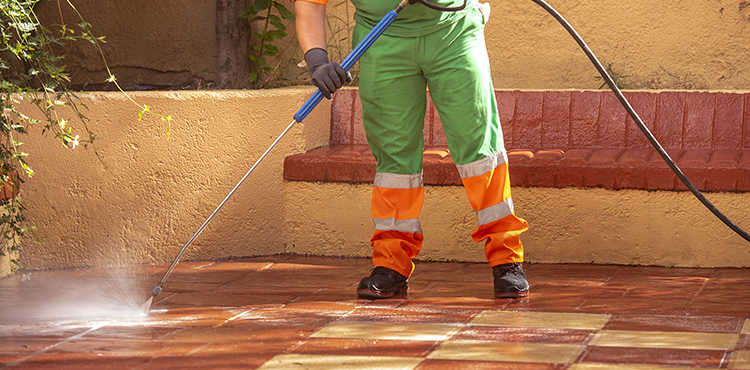
Power washing is a powerful way to remove built-up grime, mold, algae, and dirt from outdoor surfaces — but once the job is done, there’s often one lingering question: How long does it take for the surface to fully dry? Whether you’re cleaning a driveway, deck, patio, or siding, knowing the drying time is critical if you plan to paint, seal, or walk on the area afterward. ⏳🏡
Let’s explore everything that affects drying times, how long it really takes for common surfaces to dry, and tips to help you speed up the process when needed. 💡🧼
🧪 Why Drying Time Matters
Drying time isn’t just about convenience — it can make or break your results.
If you:
- Stain a deck too soon after washing, moisture trapped in the wood can cause peeling or blotchy finish 🎨🚫
- Seal concrete before it’s dry, you might lock in moisture and encourage mold growth or bubbling
- Paint siding while it’s still damp, you risk poor adhesion and premature peeling
In short: Drying fully is essential for durability, appearance, and longevity. 🌟
⏲️ General Drying Time Ranges by Surface
Here’s an overview of how long it typically takes for various surfaces to dry after power washing, assuming moderate weather conditions (sunny, 65–75°F, low humidity):
| Surface | Drying Time |
|---|---|
| Wood Deck (softwood) | 24–72 hours 🌲☀️ |
| Composite Decking | 12–24 hours 🛠️🌤️ |
| Concrete Driveway/Patio | 24–48 hours 🧱☀️ |
| Vinyl/Aluminum Siding | 2–6 hours 🏠🌞 |
| Brick Walls | 24–72 hours 🧱💨 |
| Asphalt | 24–36 hours 🛣️🌦️ |
| Roof (shingles/tiles) | 12–48 hours ⛅🏠 |
These are general estimates. Local climate, surface type, and time of day all play huge roles.
Browse Amazon Here For Popular Pressure Washers And Accessories
🌦️ Key Factors That Affect Drying Time
Let’s dive deeper into the most important variables that impact how quickly a surface will dry after pressure washing:
☀️ 1. Sunlight and Temperature
- Sunny and warm conditions are ideal. Direct sunlight speeds up evaporation.
- Cold, cloudy, or shady environments slow things down considerably.
🌞 Pro Tip: Decks and patios in full sun can dry up to 40% faster than shaded ones.
💧 2. Surface Material
- Porous materials like wood or concrete absorb water, increasing drying time.
- Non-porous materials like vinyl siding dry much faster.
💨 3. Air Circulation
Breezy days help moisture evaporate faster. Enclosed patios or narrow spaces may retain moisture longer due to poor airflow.
💨 Use portable fans to improve airflow if needed.
🌫️ 4. Humidity Levels
High humidity slows drying significantly because the air is already saturated with moisture. Dry air = fast drying.
If the humidity is over 70%, expect delays — especially for porous materials like wood and brick.
🧼 5. Amount of Water Used
- Excessive rinsing or over-soaking can saturate surfaces and extend drying time.
- A controlled, even spray helps prevent puddling.
🔍 How to Tell If a Surface Is Dry
Here are a few ways to know if your surface is ready for painting, staining, or sealing:
🪵 For Wood:
- Wood should feel dry to the touch — not cool or damp
- Press a paper towel on the surface — if it stays dry, it’s ready
- Use a moisture meter (should be under 15% moisture for sealing or staining)
🧱 For Concrete:
- Look for dark spots (still damp) vs. light uniform color (dry)
- Tape a small piece of plastic on the surface for an hour — if condensation appears, it’s still wet
🧼 For Siding:
- Simply feel the siding — if it’s no longer cool or moist to the touch, it’s good to go
- Double-check around joints, seams, or shady spots where water may linger
🚀 Tips to Speed Up Drying Time
If you’re working on a deadline or expecting rain, here’s how to help surfaces dry faster:
- Start early in the morning on a warm, sunny day
- Aim fans or blowers across the area
- Use a leaf blower to remove standing water after washing
- Work in sections to give each area maximum time to air out
- Avoid power washing the day before expected rainfall
🌧️ Never seal, stain, or paint within 24 hours of rain — even if the surface appears dry.
⚠️ What Happens If You Don’t Wait Long Enough?
Acting too soon can lead to:
- Peeling or cracking paint or stain 🎨❌
- Poor adhesion of sealants
- Trapped moisture, encouraging mildew
- A blotchy, uneven finish
Waiting might seem like a delay — but it saves you from costly rework. 🛠️
🏁 Final Thoughts
So, how long does it take for a surface to dry after power washing? It depends — but anywhere from 2 to 72 hours is typical depending on the material, weather, and other factors.
When in doubt, give it more time. Especially with porous surfaces like wood or concrete, patience equals performance. 🧼🌤️
Whether you’re sealing a driveway, staining a deck, or just returning furniture to your patio, allowing enough drying time ensures that your surface stays clean, safe, and long-lasting.
Browse Amazon Here For Popular Pressure Washers And Accessories






